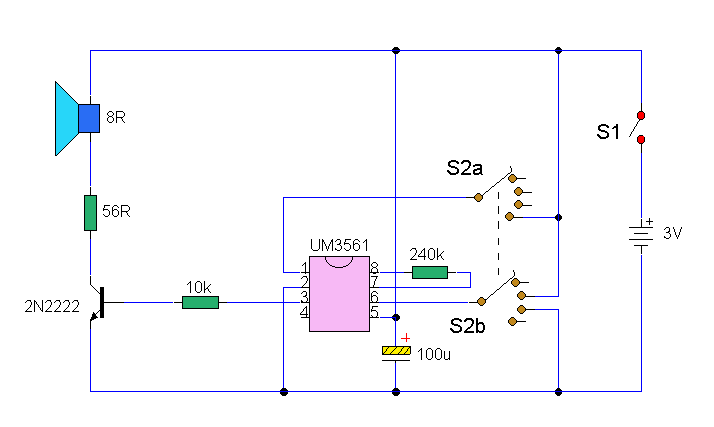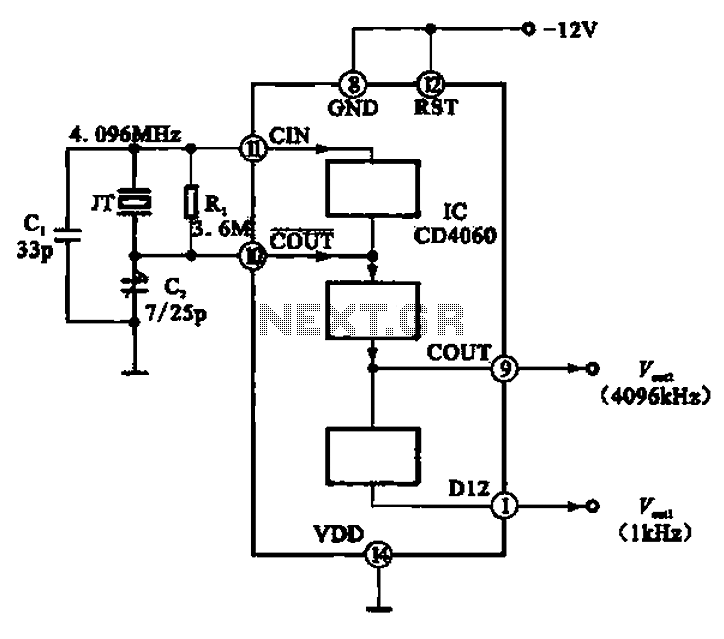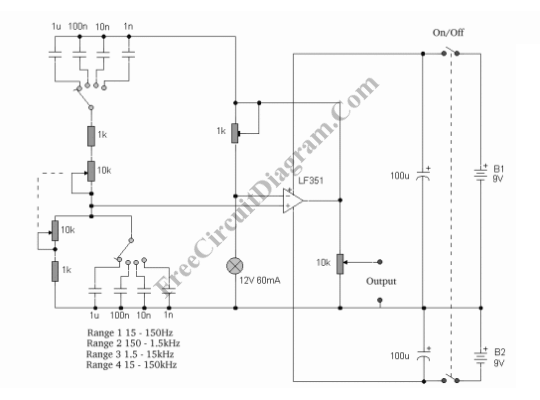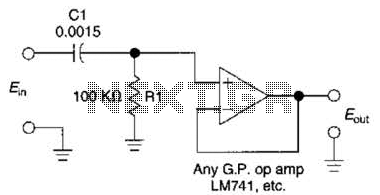
1KHz Sinewave Generators
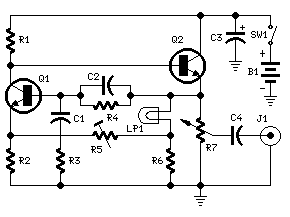
This circuit generates a stable 1 kHz sine wave using the inverted Wien bridge configuration (C1-R3 & C2-R4). It features a variable output, low distortion, and low output impedance to ensure good overload capability. A small filament lamp provides a stable long-term output amplitude waveform. This circuit is useful for testing an Audio Millivoltmeter, Audio Power Meter, and other audio circuits. Set R5 to read 1V RMS on an Audio Millivoltmeter connected to the output with R7 fully clockwise, or to observe a sine wave of 2.828V peak-to-peak on an oscilloscope.
The inverted Wien bridge oscillator is a well-regarded circuit for generating sine waves with low distortion and high stability. In this configuration, capacitors C1 and C2, along with resistors R3 and R4, form the frequency-determining network. The frequency of oscillation is primarily set by the values of these resistors and capacitors, allowing for precise tuning of the output frequency to 1 kHz.
The variable output feature is achieved through the use of a potentiometer or variable resistor (R5), which allows for adjustment of the amplitude of the output sine wave. Low distortion is maintained through careful selection of the components and the feedback mechanism, which ensures that the output closely resembles a true sine wave.
The low output impedance characteristic of the circuit is crucial for driving loads effectively without significant voltage drop, which is particularly important when interfacing with measurement equipment such as audio millivolmeters or power meters. The circuit's design incorporates a small filament lamp, which serves as a thermal feedback element. This lamp stabilizes the amplitude of the output waveform by providing a consistent load that compensates for variations in output voltage.
For practical application, the circuit can be calibrated by adjusting R5, allowing for a reading of 1V RMS on an audio millivoltmeter connected to the output. When R7 is set fully clockwise, this configuration enables observation of a sine wave with a peak-to-peak voltage of 2.828V on an oscilloscope, facilitating accurate testing and analysis of audio circuits. This versatility makes the inverted Wien bridge oscillator an essential tool for audio engineers and technicians.This circuit generates a good 1KHz sinewave using the inverted Wien bridge configuration (C1-R3 & C2-R4). Features a variable output, low distortion and low output impedance in order to obtain good overload capability.
A small filament lamp ensures a stable long term output amplitude waveform. Useful to test the Audio Millivoltmeter, Audio Power M eter and other audio circuits published in this site. Set R5 to read 1V RMS on an Audio Millivoltmeter connected to the output with R7 fully clockwise, or to view a sinewave of 2. 828V Peak-to-Peak on the oscilloscope. 🔗 External reference
The inverted Wien bridge oscillator is a well-regarded circuit for generating sine waves with low distortion and high stability. In this configuration, capacitors C1 and C2, along with resistors R3 and R4, form the frequency-determining network. The frequency of oscillation is primarily set by the values of these resistors and capacitors, allowing for precise tuning of the output frequency to 1 kHz.
The variable output feature is achieved through the use of a potentiometer or variable resistor (R5), which allows for adjustment of the amplitude of the output sine wave. Low distortion is maintained through careful selection of the components and the feedback mechanism, which ensures that the output closely resembles a true sine wave.
The low output impedance characteristic of the circuit is crucial for driving loads effectively without significant voltage drop, which is particularly important when interfacing with measurement equipment such as audio millivolmeters or power meters. The circuit's design incorporates a small filament lamp, which serves as a thermal feedback element. This lamp stabilizes the amplitude of the output waveform by providing a consistent load that compensates for variations in output voltage.
For practical application, the circuit can be calibrated by adjusting R5, allowing for a reading of 1V RMS on an audio millivoltmeter connected to the output. When R7 is set fully clockwise, this configuration enables observation of a sine wave with a peak-to-peak voltage of 2.828V on an oscilloscope, facilitating accurate testing and analysis of audio circuits. This versatility makes the inverted Wien bridge oscillator an essential tool for audio engineers and technicians.This circuit generates a good 1KHz sinewave using the inverted Wien bridge configuration (C1-R3 & C2-R4). Features a variable output, low distortion and low output impedance in order to obtain good overload capability.
A small filament lamp ensures a stable long term output amplitude waveform. Useful to test the Audio Millivoltmeter, Audio Power M eter and other audio circuits published in this site. Set R5 to read 1V RMS on an Audio Millivoltmeter connected to the output with R7 fully clockwise, or to view a sinewave of 2. 828V Peak-to-Peak on the oscilloscope. 🔗 External reference
